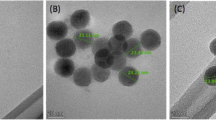Abstract
A new type of highly selective aptamer-labeled fluorescent silica nanoparticles [Apt-tris(2,2′-bipyridyl)ruthenium(II)@SiO2 NPs] were prepared through the reverse microemulsion method by using prolonged fluorescence lifetime ruthenium complexes of tris(2,2′-bipyridyl)ruthenium(II) (Ru(bpy) 2+3 ) as the source of the fluorescence for cellular prion protein imaging. Investigations showed that the newly prepared Ru(bpy) 2+3 @SiO2 NPs possessed superior advantages of strong fluorescence, low toxicity, and easy surface modification for bioconjugation. Cell imaging experiments indicated that Apt-Ru(bpy) 2+3 @SiO2 NPs had great tendency to human bone marrow neuroblastoma cells (SK-N-SH cells), since they can express large amount of prion protein on the surface of the cell, while in HeLa cells this phenomenon disappeared for the reason that HeLa cells cannot express prion proteins.






Similar content being viewed by others
References
Zhang Q, Cao YQ, Tsien RW (2007) Quantum dots provide an optical signal specific to full collapse fusion of synaptic vesicles. Proc Natl Acad Sci USA 104:17843–17848
Li X, Xue B, Li Y et al (2013) Protease-activated quantum dot probes based on fluorescence resonance energy transfer. Chin Sci Bull 58:2657–2662
Chen Z, Ren X, Tang F (2013) Optical detection of acetylcholine esterase based on CdTe quantum dots. Chin Sci Bull 58:2622–2627
Zhang B, Liu X, Li D et al (2008) Preparation of multi-color quantum dots and its application to immunohistochemical analysis. Chin Sci Bull 53:2077–2083
Zhang H, Huang X, Li L et al (2012) Photoreductive synthesis of water-soluble fluorescent metal nanoclusters. Chem Commun 48:567–569
Zhao X, Bagwe RP, Tan W (2004) Development of organic-dye-doped silica nanoparticles in a reverse microemulsion. Adv Mater 16:173–176
Gagne F, Auclair J, Turcotte P et al (2008) Ecotoxicity of CdTe quantum dots to freshwater mussels: impacts on immune system, oxidative stress and genotoxicity. Aquat Toxicol 86:333–340
Rieger S, Kulkarni RP, Darcy D et al (2005) Quantum dots are powerful multipurpose vital labeling agents in zebrafish embryos. Dev Dyn 234:670–681
King-Heiden TC, Wiecinski PN, Mangham AN et al (2009) Quantum dot nanotoxicity assessment using the zebrafish embryo. Environ Sci Technol 43:1605–1611
Xie J, Zheng Y, Ying JY (2009) Protein-directed synthesis of highly fluorescent gold nanoclusters. J Am Chem Soc 131:888–889
Lin YS, Tsai CP, Huang HY et al (2005) Well-ordered mesoporous silica nanoparticles as cell markers. Chem Mater 17:4570–4573
Santra S, Zhang P, Wang K et al (2001) Conjugation of biomolecules with luminophore-doped silica nanoparticles for photostable biomarkers. Anal Chem 73:4988–4993
Wang L, Yang C, Tan W (2005) Dual-luminophore-doped silica nanoparticles for multiplexed signaling. Nano Lett 5:37–43
Rossi LM, Shi L, Quina FH et al (2005) Stober synthesis of monodispersed luminescent silica nanoparticles for bioanalytical assays. Langmuir 21:4277–4280
Zhang J, Fu Y, Mei Y et al (2010) Fluorescent metal nanoshell probe to detect single miRNA in lung cancer cell. Anal Chem 82:4464–4471
Prusiner SB (1991) Molecular biology of prion diseases. Science 252:1515–1522
Klewpatinond M, Viles JH (2007) Fragment length influences affinity for Cu2+ and Ni2+ binding to His96 or His111 of the prion protein and spectroscopic evidence for a multiple histidine binding only at low pH. Biochem J 404:393–402
Westergard L, Christensen HM, Harris DA (2007) The cellular prion protein (PrPC): its physiological function and role in disease. Biochim Biophys Acta 1772:629–644
Campana V, Sarnataro D, Zurzolo C (2005) The highways and byways of prion protein trafficking. Trends Cell Biol 15:102–111
Zhou YW, Li CM, Liu Y et al (2013) Effective detection and cell imaging of prion protein with new prepared targetable yellow-emission silver nanoclusters. Analyst 138:873–878
Shangguan D, Li Y, Tang Z et al (2006) Aptamers evolved from live cells as effective molecular probes for cancer study. Proc Natl Acad Sci USA 103:11838–11843
Bunka DH, Stockley PG (2006) Aptamers come of age—at last. Nat Rev Microbiol 4:588–596
Jayasena SD (1999) Aptamers: an emerging class of molecules that rival antibodies in diagnostics. Clin Chem 45:1628–1650
Xiao SJ, Hu PP, Wu XD et al (2010) Sensitive discrimination and detection of prion disease-associated isoform with a dual-aptamer strategy by developing a sandwich structure of magnetic microparticles and quantum dots. Anal Chem 82:9736–9742
Xiao SJ, Hu PP, Li YF et al (2009) Aptamer-mediated turn-on fluorescence assay for prion protein based on guanine quenched fluophor. Talanta 79:1283–1286
Chen LQ, Xiao SJ, Peng L et al (2010) Aptamer-based silver nanoparticles used for intracellular protein imaging and single nanoparticle spectral analysis. J Phys Chem B 114:3655–3659
Javier DJ, Nitin N, Levy M et al (2008) Aptamer-targeted gold nanoparticles as molecular-specific contrast agents for reflectance imaging. Bioconj Chem 19:1309–1312
Li Z, Huang P, He R et al (2010) Aptamer-conjugated dendrimer-modified quantum dots for cancer cell targeting and imaging. Mater Lett 64:375–378
Medley CD, Smith JE, Tang Z et al (2008) Gold nanoparticle-based colorimetric assay for the direct detection of cancerous cells. Anal Chem 80:1067–1072
Takemura K, Wang P, Vorberg I et al (2006) DNA aptamers that bind to PrPC and not PrPSc show sequence and structure specificity. Exp Biol Med 231:204–214
Zhang J, Fu Y, Lakowicz JR (2007) Emission behavior of fluorescently labeled silver nanoshell: enhanced self-quenching by metal nanostructure. J Phys Chem C 111:1955–1961
Acknowledgments
This work was supported by the National Basic Research Program of China (2011CB933600).
Author information
Authors and Affiliations
Corresponding author
Electronic supplementary material
Below is the link to the electronic supplementary material.
About this article
Cite this article
Wang, W., Yan, X.L., Zhan, L. et al. Cellular prion protein imaging analysis with aptamer-labeled Ru(bpy) 2+3 -doped silica nanoparticles. Chin. Sci. Bull. 59, 147–153 (2014). https://doi.org/10.1007/s11434-013-0052-1
Received:
Accepted:
Published:
Issue Date:
DOI: https://doi.org/10.1007/s11434-013-0052-1




